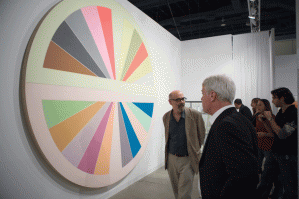« Editor's Picks
Is the time of the dealers back?
By Raúl Martínez
Until the recession took over the art market talk, one of the most discussed topics in 2008 was Damien Hirst’s decision to sell brand-new work at auction. According to the artist, it was a more democratic way to sell art, and a gesture against the greed and snobbery that defined the art market’s boom period. “What I find unfair is the Van Gogh thing. The artist doesn’t make any money, but everyone else does,” he said. For many dealers, it was also another threatening incursion of the auction houses into the primary market. Rumors sparked that Murakami and Koons might soon follow suit.
In the current art market, such rebellious gestures seem unlikely, at least in the short run. As Christie’s and Sotheby’s half-year results demonstrate, today’s sellers seem/may be less attracted by the auction salesroom’s risk and visibility. Without the lure of financial guarantees, more and more collectors choose rather to sell privately. A more discreet option, private sales prevent speculation around the motive of the sale. Most importantly, they avoid the risk of seeing your works flop. If your painting is on the cover of an auction catalog and it has been marketed globally and then does not sell, ouch. You will probably not be able to sell it in a couple of years “If it doesn’t sell privately, at least it’s not a public event,” said Michael Findlay, Acquavella Galleries.
For some buyers, the fanfare of the auction room has also lost some appeal. As businesses across all industries cut jobs, citizens are more aware of the way our leaders spend money. Habits that just a year ago could arouse envy and admiration are increasingly perceived as irresponsible or tasteless gestures. If you are spending the bonuses from AIG or a bailed-out company, the last thing you want is to be seen buying/trading at auction. Those who can afford to buy art now try to be more discreet than usual.
A growing concern for discretion, however, might be one of this year’s best news for many dealers. After losing power to auction houses, it could bring consignments back to their offices. After all, they have traditionally claimed recessions are the time of the dealers. As dealer Paul Gray told Artinfo, “There are things we have this year [at Art Basel] that we wouldn’t have had last year, because the auction houses no longer hold the advantage by throwing money at consignors. We have the advantage now.” Distressed sellers see private sales as a more discreet alternative, cashing in their works before the auction season allows. With prices in flux, collectors may prefer the flexibility of a private sale option. “It allows collectors to have control over the prices. If the price is not satisfactory, they can just walk away.”
Does it mean power will shift away from the auction houses and back to the galleries? Is the time of the dealers really coming back? It is hard to tell. The biggest drawback to these arguments is that auction houses conduct private sales too. And as they have reported over the past weeks, it is one of the departments that is performing better across the crisis. Christie’s reported sales of almost $200 million during the first half of the year (just slightly down from 2008 figures), including several $30 million transactions. Sotheby’s private sales rose by 46% in the second quarter of the year to $134 million.
Even from a private sales perspective, auction houses have numerous advantages over private dealers. In the current art market, the biggest challenge may not be to find material, but to reach the buyers. And as Brett Gorvy, International Co-Head of PostWar and Contemporary Art at Christie’s said in a recent interview, “What gives the auction house the greatest strength is the reach that we have. I’ve got 60, 70 colleagues just in the Post-War and Contemporary Art department working around the world. I have access to emerging markets, to people who have never appeared on the gallery scene before. If I get something for sale (privately), I can pick up the telephone, and within our internal network, I can place this work very carefully.… Without crushing the dreams of the dealers, the biggest challenge dealers face is reaching the buyers.” If you have ever seen how many works Mr. Gorvy wins on behalf of his anonymous bidders at auction, it is evident he knows where they are.
Raúl Martínez is an economist and writer based in New York.



































